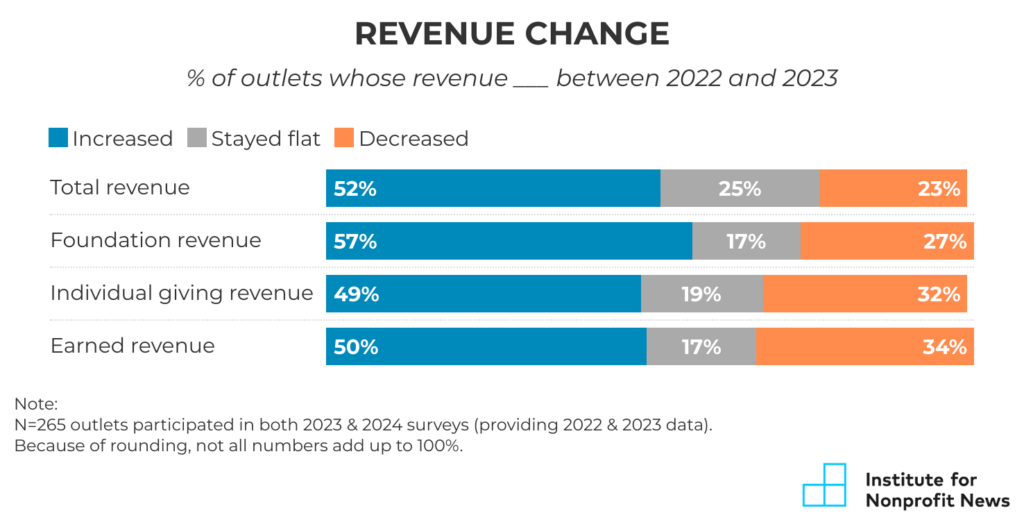
June 5, 2024
By Emily Roseman, Jesse Holcomb and Karen Rundlet
Over the seven years the Institute for Nonprofit News (INN) has studied the nonprofit news sector, the signals have pointed in the same direction: growth. This year, the signals were a little more mixed than usual.
There is certainly good news to be found in the data released today from INN’s Index survey, which is completed annually by INN’s member newsrooms across North America. More nonprofit news startups are launching, while longstanding outlets are enduring. The total revenue pie is growing too, funding an expanding pool of journalists reporting for nonprofit news outlets.
These findings, coupled with others from the 2023 Index survey, suggest a stable nonprofit news sector in a wider media environment that is anything but.

The digital-first nonprofit news sector1 is fueled by $600 million — money that powers more than 4,500 staffers across 350+ independent news outlets. And the funding is increasing.
The overall revenue numbers for 2023 represent a 22% growth from the previous year, while the number of outlets in INN’s sample grew by 11%. Staffing trends tell a similar story of year over year growth.
At the same time, some high-profile nonprofit news outlets have announced layoffs and closures. Texas Tribune and Futuro Media downsized. Journalists at The City took pay cuts. Southerly, The Tyler Loop, and other fantastic nonprofit outlets closed their doors in 2023.
What’s the real story? The full picture is neither feast nor famine. When reconciled with the headlines and the real experiences of leadership and journalists across the INN Network, the data shows gains and some threats to sustainability.
Here are some highlights from the most recent INN Index. (See methods here for a picture of who took the survey.)
Revenue and staffing numbers alone don’t tell the whole story of the state of nonprofit news.
Several nonprofit outlets are merging (including CIR and Mother Jones, CalMatters and The Markup, The Counter and Grist), with more on the horizon. These are organizations that have decided they are stronger together.
Many of the sector’s key early founders are stepping down or retiring (see YES! Media, Outlier, City Bureau, Injustice Watch and MLK50). Such changes signal a passing of the baton to the next generation of nonprofit news leaders.
National, philanthropic funding is becoming increasingly coordinated and centralized within the Press Forward umbrella. The U.S. presidential election, and its impact, looms. The only thing that’s certain is uncertainty. It’s unclear how these changes will affect funding patterns.
Nonprofit news must adapt to the shifting tides. It’s crucial that outlets are equipped with agile and entrepreneurial leaders with written succession plans in place. Nonprofit news leaders should continue to explore and build revenue from advertising, sponsorship, underwriting and local and community grants, in addition to national grants and collective fundraising programs NewsMatch.
Promising trends reflected in the Index data does not mean nonprofit news is foolproof. But by tracking and reporting such trends in nonprofit news, INN continues its role as an informed partner on news outlets’ journey to sustainability.
Karen Rundlet and Emily Roseman are INN’s CEO and research director, respectively. For the past several years, INN has collaborated with Calvin University Associate Professor Jesse Holcomb to produce the Index reports.
INN’s Index is made possible thanks to the Knight Foundation along with INN’s individual donors and its general support funders, including Arnold Ventures, Arthur Vining Davis Foundation, Democracy Fund, Hubbard Family Foundation, Inasmuch Foundation, Jonathan Logan Family Foundation, Nan H. Altmayer Charitable Trust, Mostyn Foundation, Present Progressive Fund, PCLB Foundation, The Baltimore Family Foundation, The John D. and Catherine T. MacArthur Foundation, The Schaffer Family Foundation, and The William and Flora Hewlett Foundation.
This article was originally published on INNsights.
1. INN’s primarily digital newsrooms account for more than 95% of its membership, however, nearly two dozen public broadcasters are part of the INN Network. Due to their organizational structures, it is difficult to estimate both the amount of revenue tied to the news operations of these broadcasters, as well as the size of their newsroom staff. Nevertheless, if INN’s public broadcasting members were added to these figures, the estimated total revenue across the entire field would edge closer to $700 million-$900 million.
Back to top